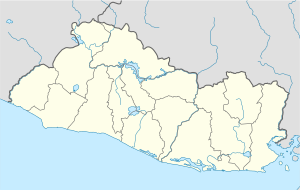Cuisnahuat facts for kids
Quick facts for kids
Cuisnahuat
|
|
|---|---|
|
Municipality
|
|
| Country | |
| Department | Sonsonate |
| Area | |
| • Municipality | 28.20 sq mi (73.03 km2) |
| Elevation | 1,410 ft (430 m) |
| Population | |
| • Municipality | 12,676 |
Cuisnahuat is a town and a municipality in the country of El Salvador. It is located in the Sonsonate department. The name Cuisnahuat comes from the Nawat language, which is an indigenous language of the region. In Nawat, it is called Kwisnāwat.
Contents
What is Cuisnahuat?
Cuisnahuat is a municipality, which means it's a local government area. It includes the main town of Cuisnahuat and several smaller villages or communities around it. Think of it like a county or a district in some other countries.
Where is Cuisnahuat Located?
Cuisnahuat is found in the western part of El Salvador. It's part of the Sonsonate department, which is one of El Salvador's 14 departments. The town sits about 430 meters (about 1,410 feet) above sea level. This elevation gives it a slightly different climate than areas closer to the coast.
How Big is Cuisnahuat?
The municipality of Cuisnahuat covers an area of about 73.03 square kilometers (around 28 square miles). This makes it a medium-sized municipality in El Salvador.
Who Lives in Cuisnahuat?
According to recent information, about 12,676 people live in the municipality of Cuisnahuat. This population includes people living in the main town and in the surrounding rural areas.
Government in Cuisnahuat
Like all municipalities, Cuisnahuat has its own local government. This government helps manage local services and make decisions for the community.
Who is the Mayor?
The leader of the municipality is called the Mayor. The current Mayor of Cuisnahuat is Gustavo Ernesto Sierra Pérez. The Mayor and the local council work together to serve the people of Cuisnahuat.
Culture and Language
The name Cuisnahuat itself tells us something important about its history. It comes from the Nawat language.
The Nawat Language
The Nawat language (also known as Pipil) is an indigenous language spoken by some people in El Salvador. It's a reminder of the rich history and culture of the native people who lived in this area long ago. While Spanish is the main language spoken today, the Nawat language is an important part of the region's heritage.
See also
 In Spanish: Cuisnahuat para niños
In Spanish: Cuisnahuat para niños


